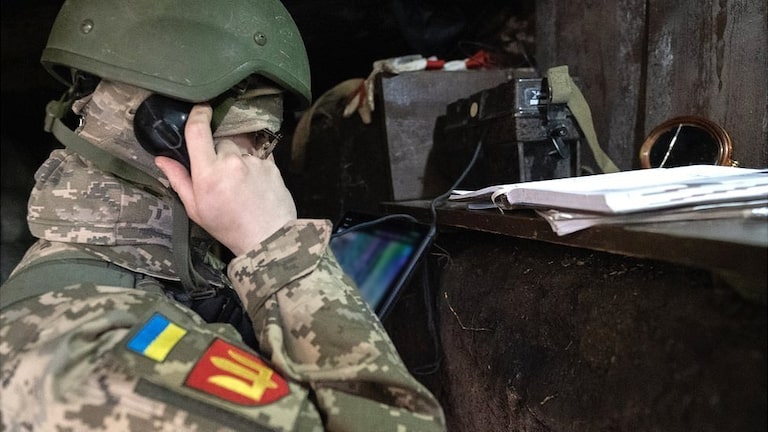Ukraine found it increasingly difficult to hide from Russian eyes the large number of soldiers it was amassing for its major offensive, so new tactics had to be found to confuse the enemy.
In a trench on the Eastern Front, a Ukrainian mortar team not only tries to track them down with Russian drones, but Uses electronic warfare to detect your position.
The men of the 28th Ukrainian regiment have access to 21st-century technology: satellites, smartphones and tablets to help them communicate and identify targets. But they use a machine from the distant past.
A monument that never appeared outside the trenches during World War I: An old crank telephone.
Against Russia’s technological prowess
Vlad and his men pick up the field phone every time they go to fire a mortar. Its mellow sound evokes the sound of another era. To make outgoing calls, they need to crank. It is like a scene from a black and white film.
Vlad grabs the extension cables to other trenches nearby. He says it is a highly secure communication device and “impossible to block”.
Russian electronic warfare systems can detect and intercept mobile phones and radios, he says, but pointing to his old field phone, Vlad says, “This technology is very old, but it works well.”
Russia’s conventional forces may have fared poorly and suffered heavy losses so far, but that’s not to say the Kremlin doesn’t have some of the world’s most sophisticated electronic warfare systems at its disposal: tracking and intercepting an invisible enemy or jamming communications. .
With these systems in constant defensive positions, Ukrainian advances will be more dangerous and difficult: Russian Zoopark radars can detect artillery fire, Zhitel vehicles can detect, track and jam radio frequencies, and Borisoglebsk-2 can disrupt satellite communications.
The age of drones
Russia’s use of electronic warfare makes it difficult for the Ukrainian military to use drones, a key tool for obtaining an aerial view of the battlefield.
Elsewhere on the Eastern Front, Oleksii and his 59th Brigade drone reconnaissance unit use the cover of a bombed-out building to fly their small Chinese commercial drone to identify Russian positions.
In the early stages of the war, Ukraine appeared to be very adept at using drones. But Oleksy says now “The Sky is Full” of Drones of All Kinds. The Russians use the same models, but they have more, he says. Although he believes they “could care less”.
Oleksii says he has already lost five small Chinese-made drones and that his squadron “could lose three to four drones a day.” It says the enemy has radio-electronic warfare stations and anti-drone guns that can “transmit jamming and disrupt communications” to disable their drones.
But in skilled hands, a small commercial drone like the Mavic can last “two to three weeks.”
They try to avoid detection by using encryption and changing the geolocation of their drones. Flying over the Russian trenches using a VPN in Australia makes it look like flying over that continent. But it says Disguise doesn’t always work.
On the downside
In contrast, Ukraine’s efforts to shoot down Russian drones could turn out to be more fundamental, as we are witnessing on another level.
Ukrainian soldiers point to a drone flying high in the distance. It’s the Orlan, a large Russian-made drone designed for surveillance or interception of communications. This time he examines nearby Ukrainian defensive positions. To direct artillery fire.
The sound of shells is heard before the impact and smoke can be seen in the distance.
The response of nearby Ukrainian soldiers was to fire into the air with their automatic rifles. But the Russian drone is much taller. In this case, your fire is useless.
In a nearby command center, Bohdan, of Ukraine’s 10th Regiment, reveals His frustration at not being able to do more. Russian drones “fly every day, every hour, every second. They have the resources to do so. We’re making war on it, but not as much as we’d like.”
However, the large screen behind him shows that Ukraine can still do the same, although they must now treat their drones as expendable war items.
We see a live video feed of a Ukrainian drone hovering over nearby trenches. Russia may have an advantage in electronic warfare and multiple drones that could challenge Ukraine’s next attack.
But Russia has yet to gain control of the skies or defeat Ukraine’s resistance and ingenuity.
Jonathan Peel, BBC security correspondent

